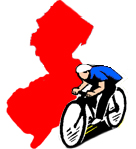1. What is "randonneuring?"
Randonneuring is unsupported, long-distance cycling. This style of riding is non-competitive in nature, and self-sufficiency is paramount. When riders participate in randonneuring events, they are part of a long tradition that goes back to the beginning of the sport of cycling in France and Italy. Friendly camaraderie, not competition, is the hallmark of randonneuring. (from the Randonneurs USA website: www.rusa.org)
2. What is a "brevet?"
This is a French word that means "certificate" or "diploma." A brevet, also sometimes called a "randonnee," is the event randonneurs often enter. This is almost always a ride of 200 kilometers or more. Riders completing brevets of 200, 300, 400 and 600 kilometers are said to have completed a "full brevet series." Brevets have a time limit for each distance. For example, the typical limit for the entry-level brevet, the 200k, is 13 hours, 30 minutes.
3. What is a "brevet card?"
This term is actually redundant, given that "brevet" can mean "certificate" in French. The brevet card is given to each entrant in a brevet and it must be filled out at each controle along the route. Riders cannot receive official credit for finishing a brevet, without a signed and completed brevet card. Keep it in a safe place (not in your jersey pocket!)
4. What is a "controle?"
A controle is a kind of checkpoint along a brevet course. At each controle, riders must add certain information to their brevet card. At a manned controle, the volunteer will sign the card. At an unmanned controle, the rider may have to have a store owner sign it. At an information controle, the rider may have to answer a question related to the controle. Often, though not always, there is food and drink at a controle.
5. What is the RUSA and why should I care?
RUSA stands for Randonneurs USA, the national organization set up to promote randonneuring in the U.S. and assist American randonneurs. RUSA issues memberships to American randonneurs, but does not organize rides. It delegates the organization of rides to Regional Brevet Administrators ("RBA") and bicycle clubs all over the country. RUSA also frequently serves as the liason between RBAs and the Audax Club Parisien. You need to join RUSA if you want to qualify for the 1200km Paris-Brest-Paris ride.
6. What is the ACP and why should I care?
The ACP is the Audax Club Parisien. It has an illustrious history. It was founded in 1904 by Henri Desgranges, who founded the Tour de France the year before. The ACP runs the most famous randonneuring event of all, Paris-Brest-Paris and works with randonneuring organizations in dozens of countries around the world.
7. What is PBP?
PBP stands for Paris-Brest-Paris, a 1200km ride that began as a race in 1891 (twelve years before the Tour de France started) and continues as the world's premier randonneuring event. To have completed PBP within the 90-hour time limit is perhaps the most coveted honor in our sport. PBP will next be held in August 2011. To qualify, you must complete a full brevet series of 200, 300, 400 and 600 kilometers within the cutoff date in June, 2011. You must join RUSA before entering any of those qualifying rides.
8. What equipment do I need for riding brevets?
People complete brevets on many different kinds of bicycles, including recumbents and mountain bikes, though standard road bikes predominate. Nearly all brevets require front and rear lighting. Anyone who has ridden a bicycle for long distances knows how important the saddle is to a rider's comfort.
9. How can I possibly ride enough miles to train for such long events?
The Chinese philosopher known as Lao Tzu said that a journey of 1,000 miles begins with a single step. Worrying about finishing a 1200 km ride before ever attempting a 200km one is not wise. If you can train for a century, you can prepare yourself for a 200k, which is just a century plus 25 miles. The brevet series itself helps train you for progressively longer distances of 300, 400 and 600 kilometers.
10. If I am not a fast rider, will I be able to complete brevets on time?
Anyone who has completed the longer brevets (say 400km or longer) knows that mental strength often prevails over physical strength. There are plenty of faster riders who can't finish longer brevets and plenty of slower ones who can. The brevets are generally set up so that if you can average 10 mph, including stops, you'll make it every time. So the less time you stop, the slower you need to ride. Smart planning sometimes beats strong legs.
|

